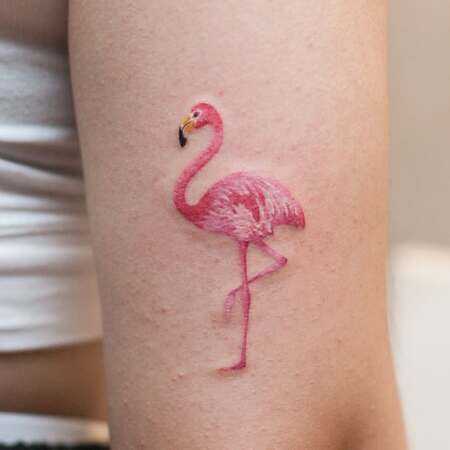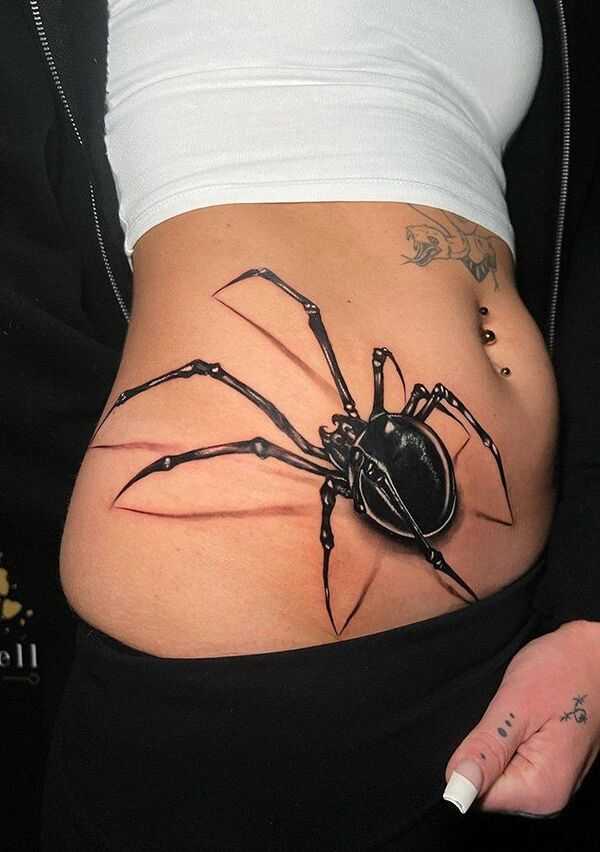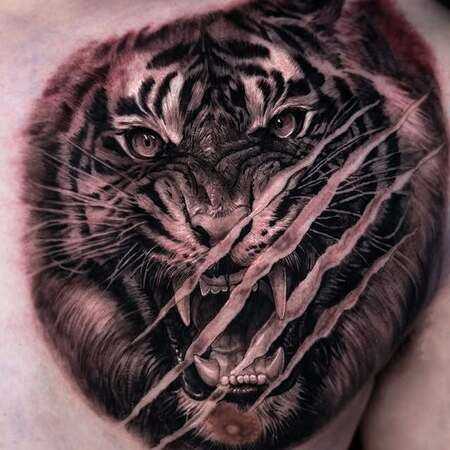Flower tattoos have become more than just a trend in the world of body art. They are powerful symbols that allow individuals to express their identity, emotions, and life experiences through intricate and meaningful designs. From delicate petals to vibrant blooms, flowers have always held deep significance across cultures and histories, making them an ideal choice for those looking to ink their journey onto their skin. Whether they represent love, strength, renewal, or transformation, flower ink is more than just beautiful art—they are a reflection of who we are and the stories we wish to share with the world.
Flower Tattoos as Expressions of Personal Identity
Flower tattoos are far from mere decorations; they are a potent means of self-expression that reflect an individual’s personal identity. Over time, flowers have transcended their role as simple botanical images to become symbols of a deeper, more profound connection to one’s inner self, experiences, and emotions. As an art form, flower ink embodies not only the aesthetics of nature but also offers a space for personal storytelling, representing significant milestones, cultural heritage, and unique life journeys.
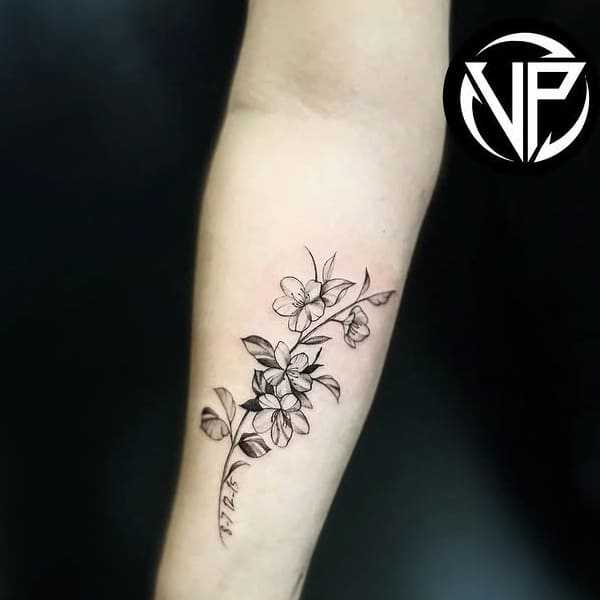
The Deep Symbolism
At the core of flower ink is its symbolic value. Flowers, with their soft petals and vibrant colors, have always been symbols of love, growth, and human connection. Different flowers carry distinct meanings that resonate with individuals on personal levels, making them powerful symbols of identity.
For example, a rose is often seen as a symbol of love and passion, but it can also symbolize resilience, with its thorns representing the hardships and challenges in life. A lotus, on the other hand, speaks to spiritual enlightenment and transformation, representing a person’s journey from struggle to peace and enlightenment. These meanings are not just general; they hold unique significance to the wearer, representing their struggles, triumphs, relationships, and spiritual evolution.
Reflection of Cultural Heritage
Botanical tattoos are also an important medium for connecting to cultural roots and traditions. Many flowers are deeply embedded in cultural practices and beliefs, and their tattoos serve as a bridge to one’s ancestral legacy. Cherry blossoms, for instance, have a rich cultural significance in Japan, symbolizing the fleeting nature of life, renewal, and the beauty found in impermanence. For those of Japanese descent, this tattoo might serve as a reminder of heritage and the transient beauty of existence.
Similarly, the sunflower, with its bright and cheerful appearance, is often associated with positivity, strength, and vitality in Western cultures. For some, getting a sunflower tattoo may not only reflect a love for nature but also a connection to these values. The choice of flower in a tattoo can be an act of honoring one’s ancestry, incorporating meaningful cultural symbols that speak to personal identity.
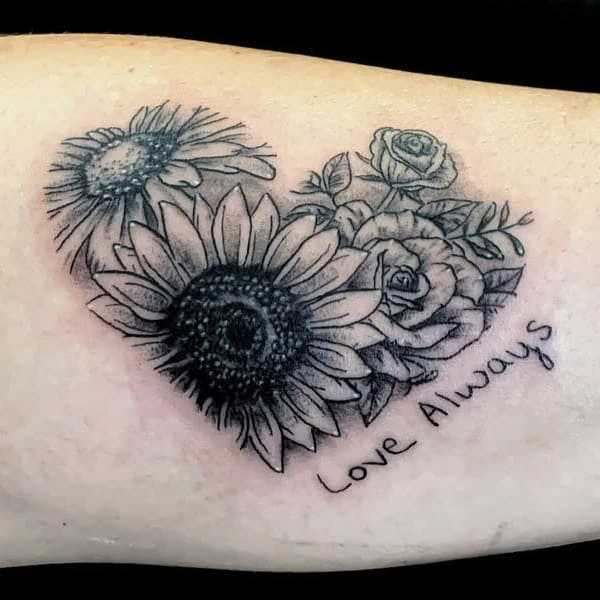
Milestones and Markers of Life
Beyond their symbolic meanings, bloom tattoos often serve as permanent reminders of important life events. Flowers, in their various stages of blooming, are representative of life’s many phases, from new beginnings to endings. A freshly bloomed flower might symbolize a new chapter in life, such as a significant personal achievement, a birth, or a fresh start. Conversely, a wilting flower or a flower with a broken stem might symbolize loss, grief, or a tribute to someone who has passed.
These tattoos become more than just ink—they tell a personal story, marking moments of joy, sadness, growth, and healing on the skin. They allow individuals to visually express their inner experiences, whether it’s the beauty of a life well-lived or the pain of a loss endured. Each flower, each petal, represents a page in the wearer’s personal story, immortalizing their memories in a tangible form.
Personalization and Customization: Designing Your Flower Tattoo
One of the most significant aspects of flower tattoos is the endless potential for customization. Unlike other designs, flowers can be combined in countless ways to create something entirely unique.
Choosing which flowers to include, deciding on placement, and selecting colors are all parts of the customization process. For example, a person may choose a daisy for its simplicity and purity, while another may opt for a vibrant hibiscus to reflect their bold, adventurous spirit. The style of the tattoo can also vary greatly—some people prefer delicate, line-drawing representations of flowers, while others may opt for a more detailed, realistic approach, or even a watercolor design. Through these choices, flower ink becomes more than just art; it transforms into a visual representation of the individual’s personality, preferences, and worldview. This level of personalization ensures that no two floral skin art are ever exactly alike, reinforcing their role as a unique and personal expression of identity.
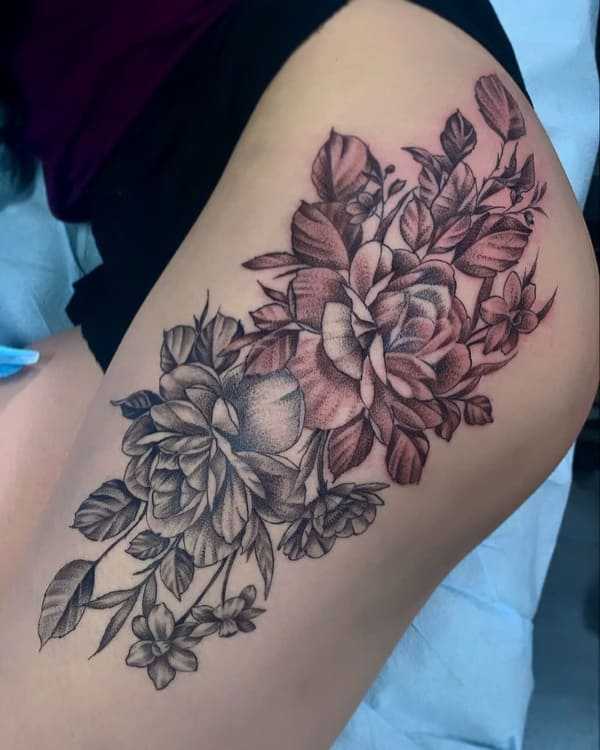
The Emotional Connection: Flowers as Emotional Markers
Flower ink often carries a profound emotional weight, reflecting the wearer’s inner landscape. They can symbolize hope, joy, and optimism, or conversely, they can represent resilience in the face of hardship. A sunflower, often seen as a symbol of positivity, can be a tribute to a joyful spirit, while a rose can signify love, both romantic and familial, or the complex nature of human emotion.
These tattoos can also be markers of personal strength and transformation. A blooming flower may symbolize personal growth, while a faded or dying flower can represent a life experience that has shaped the individual—whether it’s a difficult period that led to personal development or a turning point that led to healing and renewal. The beauty of flowers is that they capture not only moments in life but also the emotions tied to them, creating a visual representation of the wearer’s emotional journey.
Journey of Self-Discovery
Ultimately, botanical tattoos serve as an outward expression of an ongoing journey of self-discovery. Whether they represent personal milestones, cultural connections, or emotional resilience, these tattoos act as constant reminders of who we are and who we are becoming. The act of getting a flower tattoo is deeply personal; it requires introspection, thoughtfulness, and an understanding of one’s self. As people change and evolve, so too does the meaning of their tattoos, making them dynamic reflections of personal identity.
To sum up, flower tattoos are powerful expressions of personal identity. They are more than just artistic representations of nature—they are deeply meaningful symbols that tell the story of who we are, where we come from, and where we are headed. Through their intricate designs and symbolic meanings, flower designs provide individuals with a way to visually communicate their personal experiences, emotional landscapes, and cultural connections. Whether it’s a symbol of love, strength, growth, or transformation, flowers are timeless emblems of the unique and beautiful identities that make us who we are.
Flower Tattoos for Every Season: Spring, Summer, Fall, and Winter
Flower tattoos are timeless, capturing the essence of each season. From the vibrant blooms of spring to the serene elegance of winter, these tattoos symbolize growth, beauty, and transformation. Whether you prefer the soft pastels of spring or the rich colors of fall, there’s a floral design to reflect every season. In this guide, we explore how to incorporate seasonal flowers into your tattoo design, celebrating nature’s ever-changing beauty.
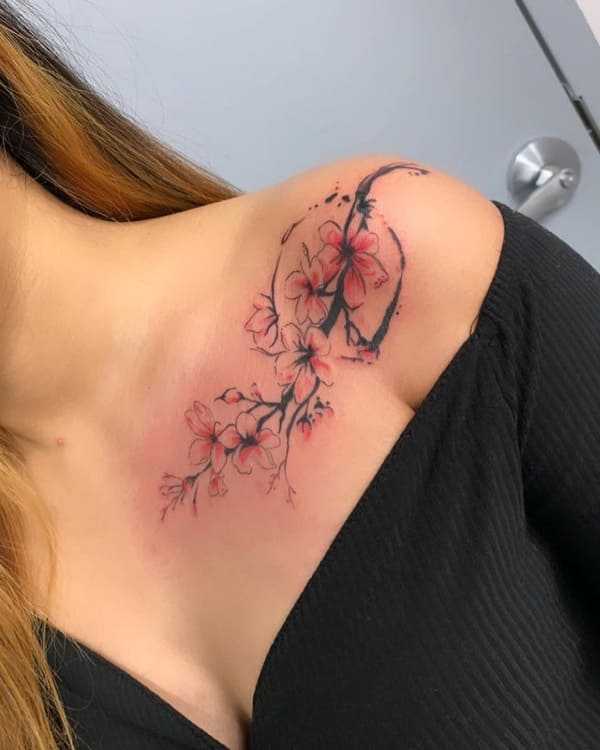
Spring: A Time of Rebirth and Renewal
Spring is a season of renewal, symbolizing new beginnings and growth. As nature awakens, blossoms such as lilies, hyacinths, crocuses, and cherry blossoms bloom, representing hope, youth, and the beauty of life’s cycles. A tattoo featuring seasonal spring blooms often reflects innocence, optimism, and the start of a fresh chapter. Tulips symbolize perfect love and prosperity, while daffodils represent rebirth and new beginnings. Cherry blossoms, iconic in both Japanese and Western cultures, remind us of the ephemeral beauty of existence. A spring flower tattoo, often designed in soft pastels, captures the delicate and ethereal beauty of the season.
Summer: Bold, Vibrant, and Full of Life
Summer is all about boldness, warmth, and the abundance of life. Flowers in this season are at their fullest, bursting with vibrant colors and energy. Sunflowers, daisies, hibiscus, and roses are often associated with the summer months, each bringing a unique flair to floral tattoo designs. Summer flowers tend to be brighter and bolder, showcasing the vitality and exuberance of the season.
Sunflowers are perhaps the most iconic of all summer flowers, with their golden-yellow petals and large, round faces that follow the sun. These flowers symbolize warmth, positivity, and happiness, making them a popular choice for tattoo designs that aim to evoke a sense of joy and optimism. Hibiscus flowers, commonly seen in tropical regions, have a bold, exotic look and represent beauty, strength, and femininity. Their vibrant hues—often seen in shades of pink, red, and yellow—can make for striking tattoos that stand out.
Daisies, with their simple yet cheerful appearance, symbolize purity, innocence, and new beginnings. A daisy tattoo can be designed in vibrant colors, with bright white petals and a yellow center, adding a playful and carefree touch to any tattoo collection. Summer flower ink are perfect for those who want to celebrate the warmth, freedom, and beauty that this lively season brings.
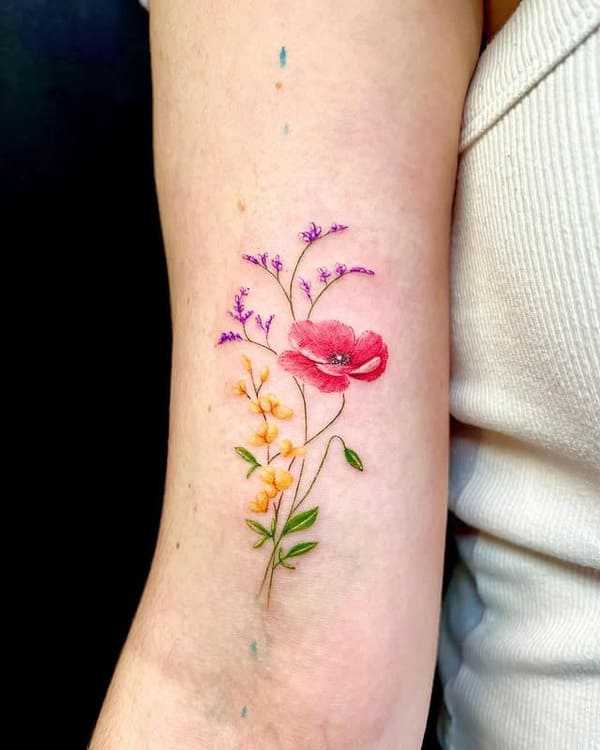
Fall: Rich, Warm, and Reflective
Fall is a season of transformation, where the vibrant greens of summer give way to rich oranges, reds, and browns. It’s a time of reflection, change, and harvesting the fruits of one’s labor. Flowers in the fall, like chrysanthemums, marigolds, and asters, offer warm hues that mirror the colors of the season and are perfect for creating tattoos that celebrate this time of year.
Chrysanthemums are highly symbolic in many cultures, especially in Asia, where they represent longevity, renewal, and joy. Their intricate petal shapes and rich colors make them perfect for fall tattoos. Marigolds, with their golden-orange petals, symbolize celebration, passion, and the beauty of life. In many cultures, marigolds are used in festivals to honor ancestors, making them a meaningful choice for those looking to commemorate family or cultural traditions.
A fall flower tattoo can be designed with rich, earthy tones that evoke the changing landscape, with deep reds, burnt oranges, and golden yellows. These colors not only reflect the beauty of the season but also represent the themes of transition, abundance, and gratitude that are central to fall. The detailed layers of petals and leaves in fall floral designs can also symbolize the shedding of the old to make way for the new, aligning with the season’s reflective qualities.
Winter: Quiet, Elegant, and Serene
Winter may bring cold, stillness, and dormancy, but it also carries an air of quiet beauty. While flowers are not as abundant in this season, winter flowers such as poinsettias, holly, camellias, and snowdrops capture the essence of winter’s understated elegance. Winter floral-themed ink is often characterized by muted colors, with a focus on creating designs that are delicate and serene.
Poinsettias, often associated with Christmas, have deep red and green hues that symbolize celebration, joy, and goodwill. Holly, with its vibrant red berries and sharp green leaves, represents protection, renewal, and festivity. Snowdrops, which bloom in the dead of winter, are a symbol of hope and the promise of new life after a cold and quiet period. These flowers are often featured in tattoos with soft, pale tones, such as icy whites, frosty blues, and deep reds, which complement the winter landscape.
A winter flower tattoo is typically designed to reflect the tranquility and beauty of the season. The minimalist style often used in winter flower tattoos—paired with intricate details—creates a peaceful, elegant design that highlights the serene nature of this cold season. For those who appreciate the quiet beauty of winter, a flower tattoo can serve as a reminder of the calm and reflective moments that winter brings.
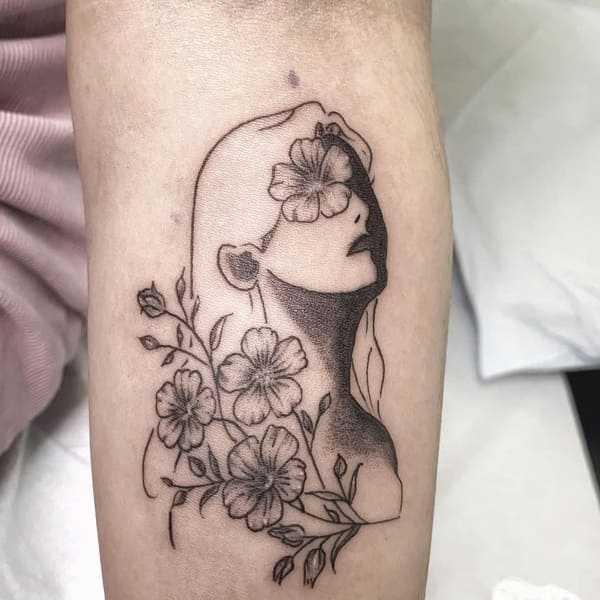
Choosing the Flower Sleeve Tattoo for Personal & Aesthetic Appeal
A flower sleeve tattoo is a stunning way to express emotions, personal stories, and cultural connections through intricate, sprawling designs. Covering the entire arm, it allows for multiple flowers, each with its own meaning and aesthetic. Choosing the right flowers requires thoughtful consideration, ensuring they reflect your identity and preferences. This guide explores how to select flowers that complement your style and hold personal significance, creating a visually striking and meaningful tattoo.
Understanding the Symbolism Behind Different Flowers
The first step in designing a botanical sleeve tattoo is choosing flowers with meaningful symbolism. Each flower carries its own message, representing emotions, concepts, or life stages. For example, roses symbolize love and passion, while lotuses represent spiritual growth and transformation. Cherry blossoms reflect the fleeting beauty of life, emphasizing the beauty of impermanence. By understanding the symbolism of flowers, you can select those that resonate with your personal experiences, beliefs, and emotions, creating a tattoo that tells a unique story.
Personal Meaning and Connection to Flowers
A flower sleeve is a deeply personal expression of identity, so it’s important to choose flowers that hold particular significance to you. Whether it’s a flower that reminds you of a meaningful experience, represents a loved one, or reflects a core value, the flowers you choose should speak to who you are. For example, a sunflower, known for its resilience and ability to thrive in harsh conditions, could symbolize strength and perseverance. A lily, often associated with purity and renewal, might represent a fresh start or a new chapter in life.
If you have a deep connection to a particular flower or memory, incorporating it into your sleeve tattoo can be a powerful way to honor that bond. Some people choose to incorporate flowers that were part of their family’s heritage, such as a specific type of bloom that holds cultural or familial significance. Others might select flowers that reflect their personal milestones, such as the birth of a child, a significant achievement, or a transformative experience.
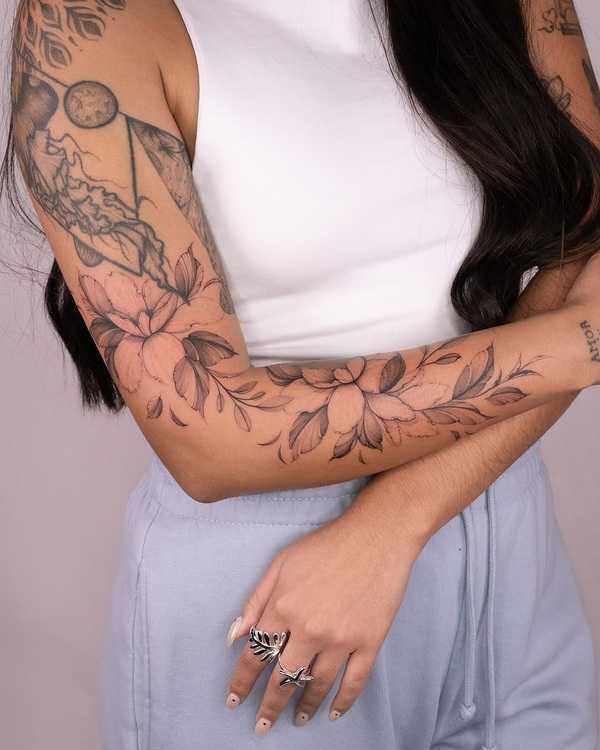
Balancing Aesthetic Appeal
While the symbolic meaning of your bloom sleeve tattoo is important, its aesthetic appeal is equally crucial. The flowers should resonate personally and complement each other visually, with careful attention to size, placement, and overall harmony. The style you choose—whether realism, watercolor, or traditional—will affect how the flowers appear and should align with the design for a cohesive look. Consider varying flower sizes and shapes to create flow and movement, using larger blooms as anchors and smaller flowers to add depth. Balancing density with negative space ensures a visually appealing and uncluttered design.
Seasonal and Color Considerations
Another important factor in creating a floral sleeve ink is considering the colors and seasonal themes of the flowers. Flowers are often associated with specific seasons, and incorporating seasonal elements into your design can add another layer of meaning and beauty. For example, spring flowers such as peonies, lilacs, and magnolias bring a fresh, vibrant energy, while autumn blooms like asters, goldenrods, and sunflowers have warmer, earthier tones that evoke feelings of harvest and change.
Color also plays a crucial role in how your flower-themed sleeve ink will be perceived. Bright, bold colors like red, yellow, and pink can create a lively, energetic design, while softer pastels or muted tones can evoke a sense of calm and tranquility. The colors of the flowers can be chosen to reflect your personal aesthetic, whether you prefer vibrant, attention-grabbing hues or a more subtle, monochromatic look.
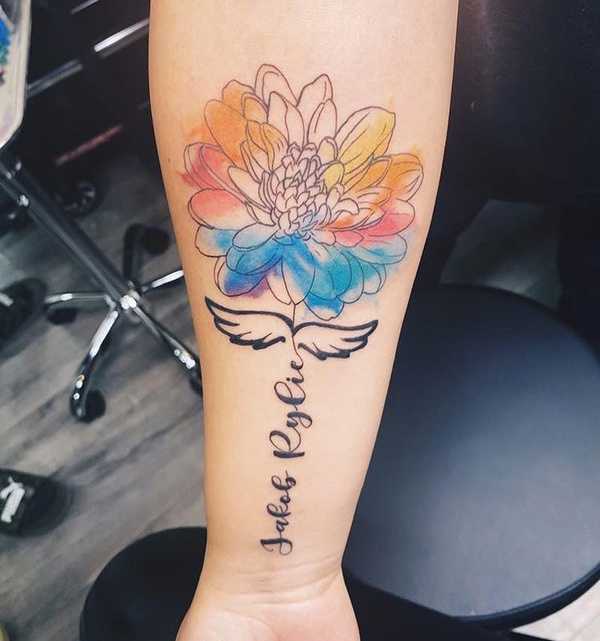
Creating a Cohesive Theme and Flow
To create a cohesive bloom sleeve tattoo, consider using a consistent theme, such as focusing on one flower type (like roses or lotuses) or maintaining a uniform color palette with different flowers. The arrangement of flowers is key for a fluid and dynamic design, ensuring they wrap naturally around your arm and complement your body’s contours. A skilled tattoo artist can help balance the design, creating a tattoo that flows seamlessly and looks harmonious from every angle.
Consulting with a Skilled Tattoo Artist
Designing a flower sleeve tattoo requires both artistic vision and technical skill. Working with an experienced tattoo artist ensures your ideas are brought to life with precision, helping you choose the right flowers, placements, and balance between personal meaning and aesthetic appeal. Selecting flowers that resonate with your life’s journey and fit into a cohesive design allows the tattoo to reflect your identity whether symbolizing love, strength, or transformation, a floral body art sleeve offers a lasting and meaningful way to express yourself through the art of floral design.
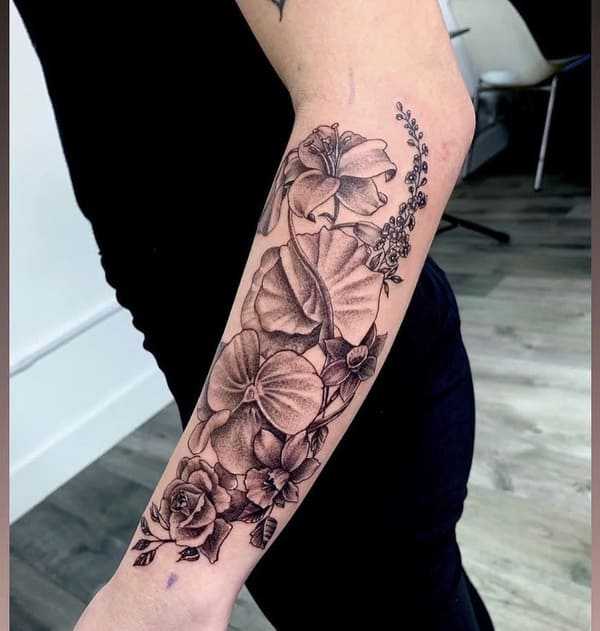
How Flower Body Art Connects Us to the Earth
Flower ink occupies a unique space in the world of body art, merging the natural beauty of the Earth with the intricate creativity of human expression. These tattoos are more than just aesthetic designs; they represent a deep connection to the environment, bringing the vibrant life of nature directly onto the skin. The intersection of nature and art in flower ink not only highlights the beauty of flowers but also serves as a form of visual storytelling that bridges the gap between our inner selves and the natural world.
Nature as a Source of Inspiration in Art
Nature has been a key source of inspiration for artists throughout history, with flowers and plants playing a prominent role in artistic expression. The organic shapes, intricate details, and vibrant colors of flowers symbolize life, growth, and transformation. In the context of tattoos, these natural elements merge with personal interpretation, creating meaningful designs. Tattoo artists often draw inspiration from botanical studies, capturing the structure of flowers with precision. Flowers represent life’s cycles and nature’s changes, and tattoo artists turn these into beautiful designs on the skin.
The Role of Flower Ink in Environmental and Ecological Awareness
In today’s world, where environmental concerns are at the forefront of global discourse, floral body art has become a medium for raising awareness about nature and ecological issues. People are increasingly turning to botanical ink as a form of advocacy, using it to symbolize a commitment to protecting the environment, conserving biodiversity, and promoting sustainability. Botanical tattoos can symbolize the beauty and fragility of nature, reminding us of the importance of protecting the environment.
For instance, the tattoo of an endangered flower species can act as a poignant reminder of the need to protect fragile ecosystems. Whether they feature wildflowers, orchids, or local blooms, botanical tattoos remind us of the beauty of nature and the connection between all living things. Through these tattoos, wearers express not only their love for nature but also their responsibility toward its conservation. Botanic ink designs are personal statements, and they also symbolize care for the environment.
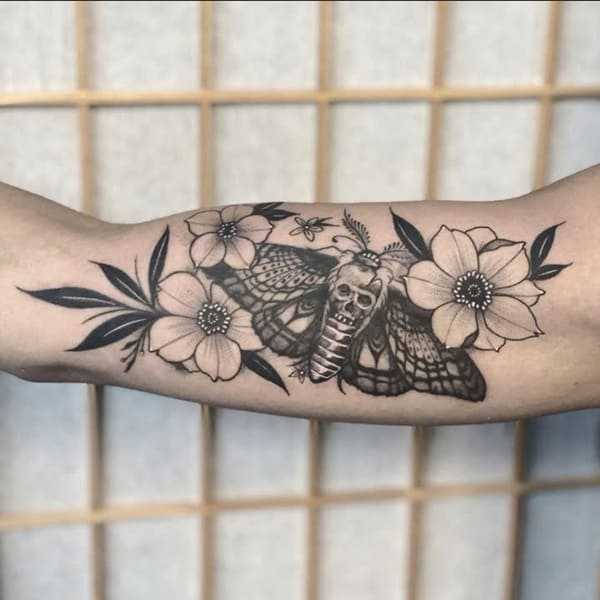
Floral Tattoos as a Reflection of Human-Nature Connection
Getting a flower tattoo is a way of showing our deep connection to nature. In today’s busy world, many people want to reconnect with nature, and flower tattoos are a way to express that desire. Flowers, as symbols of growth, renewal, and the cyclical nature of life, remind us of the natural rhythms that govern the world around us. By adorning their bodies with these symbols, individuals tap into a sense of continuity, cycles, and interconnectedness that transcend the individual self.
Floral ink designs also remind us of the intimate relationship humans have with the land. Historically, flowers have been central to human culture, serving as symbols in religious practices, rituals, and celebrations. Flowers are also part of our daily lives, whether in gardens, in the foods we eat, or in the way we use plants for medicinal purposes. By choosing flower ink, individuals not only honor nature’s beauty but also acknowledge the essential role that plants and flowers play in sustaining life on Earth.
The Evolution of Floral Tattoo Styles: Merging Tradition with Innovation
Floral tattoos have evolved by blending traditional techniques with contemporary styles, reflecting the growing sophistication of tattoo art. Traditional designs with bold lines and limited color palettes have expanded into diverse styles, such as watercolor tattoos, which mimic the soft beauty of flowers, and hyper-realistic designs that capture intricate details. Geometric botanical tattoos combine floral motifs with symmetrical patterns, offering a modern twist. The mix of traditional and modern styles reflects how our relationship with nature is changing, with flower tattoos staying relevant while keeping their deep, timeless meaning.
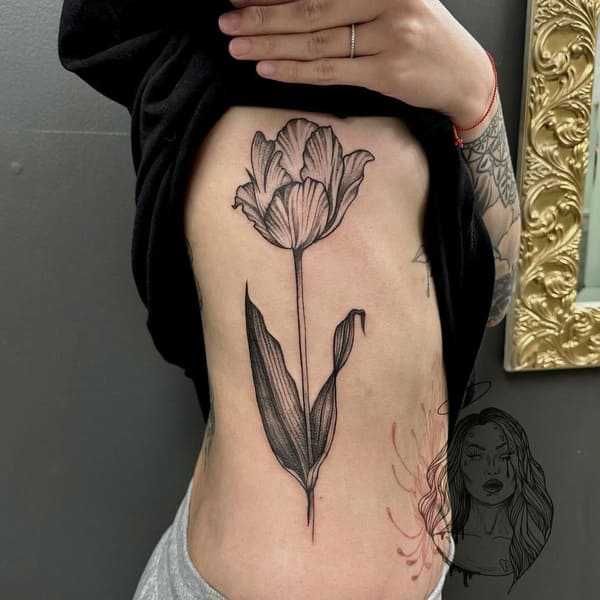
Choosing the Flower Bouquet Tattoo for Every Occasion
Flower bouquet tattoos are a timeless way to express emotions, commemorate milestones, and celebrate life’s special moments. Unlike single-flower ink, bouquet designs combine various blooms, offering deeper symbolism and intricate artistry. Whether representing love, growth, or a significant event, a botanical bouquet ink can be a perfect choice. The combination of flowers creates a highly personalized and versatile design. This guide explores how to choose the ideal bouquet tattoo that speaks to your heart and suits any occasion.
Romantic Occasions
The floral bunch tattoo beautifully symbolizes love and romantic relationships. A bouquet of flowers represents affection and appreciation, making it perfect for commemorating a significant relationship. Romantic bouquet tattoos often feature roses for passion and orchids for beauty and luxury.
For couples, a bouquet tattoo can serve as a shared symbol of unity, representing their deep connection. Some choose flowers from their wedding bouquet, making the tattoo a lasting tribute to their special day. Whether marking an anniversary, a proposal, or simply expressing devotion, a bouquet tattoo is a timeless expression of love.
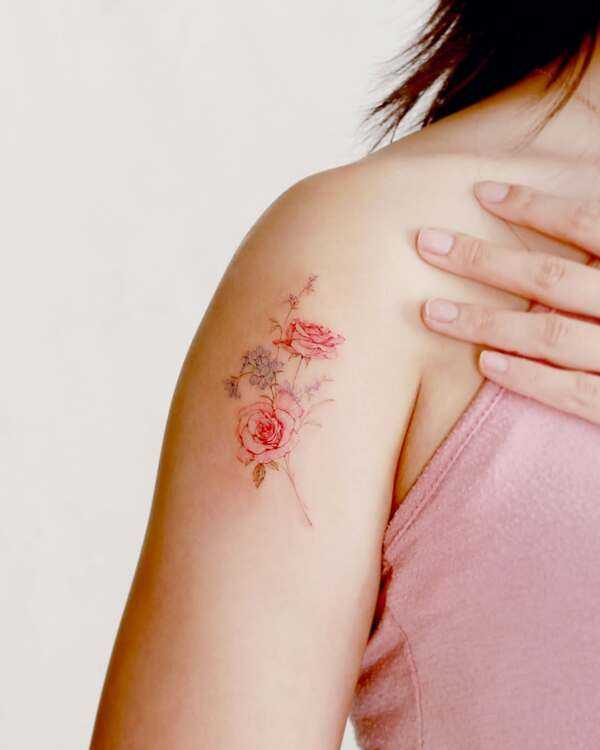
Life Milestones and Celebrations
Flower bouquets are ideal for celebrating significant life milestones like birthdays, graduations, or the birth of a child. A bouquet tattoo can symbolize fresh starts, personal achievements, or the joy of new beginnings. Lilies represent renewal, while daisies symbolize hope and positivity. A bouquet tattoo can also reflect different aspects of personal growth and life experiences. For milestones like graduation, a mix of tulips (success) and roses (admiration for supporters) can create a meaningful design. Each flower adds depth, representing emotions tied to life’s biggest moments.
Healing and Remembrance
Floral arrangement tattoos also serve as powerful symbols of remembrance, healing, and personal transformation. A bouquet can represent the beauty and strength found in the process of recovery after a hardship or loss. For example, forget-me-nots are often chosen to honor the memory of a loved one, while lotus flowers can symbolize spiritual growth and resilience after a challenging time.
These tattoos are a beautiful way to carry memories with you, honoring those who have passed or marking the end of a difficult chapter in your life. The combination of different flowers in the bouquet can serve as a tribute to both the pain and growth that accompanies healing. A bouquet tattoo of this nature can be a source of comfort, strength, and remembrance, symbolizing the healing power of love, time, and personal growth.
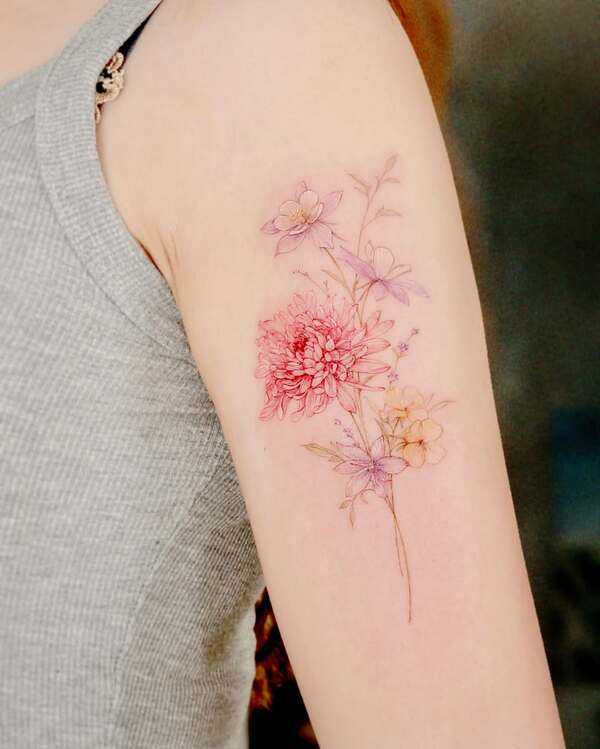
Choosing Colors and Styles for Your Bouquet Tattoo
Color plays a pivotal role in the look and feel of a flower bouquet tattoo. You can opt for a vibrant, multi-colored bouquet for a lively and dynamic design, or choose a more subdued color palette for a softer, more understated look. The colors of the flowers can align with the meaning behind each bloom—red for passion, white for purity, yellow for friendship, and purple for creativity or spirituality. A black-and-grey or monochrome design can give the tattoo a classic, timeless feel, while watercolor tattoos offer a delicate, fluid representation of flowers that mimics the organic beauty of nature.
The style of your tattoo will also influence how the bouquet is portrayed. A traditional tattoo style will feature bold outlines and saturated colors, while a more modern style might include fine lines, minimalism, or watercolor effects. A tattoo artist skilled in floral design will help you decide which style best suits your vision and body placement.
Flower Tattoo Designs: Representing the Cycle of Life
Flower tattoo designs have long been associated with the cycle of life—birth, death, and rebirth—offering a profound visual representation of the continuous flow of existence. Flowers, in their various stages of growth, bloom, and decay, mirror the human experience of transformation, growth, and the inevitability of change. From the vibrant blooms of spring to the fading petals of autumn, flowers symbolize the ever-changing flow of time, and their symbolism has made them a powerful motif in body art.
Birth and New Beginnings
In floral ink designs, birth is symbolized by blooming flowers, representing new beginnings, growth, and potential. A budding flower echoes the start of a fresh chapter, reflecting personal journeys. Daisies, tulips, and lilies symbolize birth and renewal, capturing innocence, hope, and boundless possibilities.
The vibrant hues of these flowers reflect the optimism that comes with new experiences. The bright yellow of a daisy or rich pink of a tulip evokes joy and enthusiasm, marking milestones like childbirth, career changes, or personal growth. Floral designs go beyond nature, deeply connecting to human experiences. A flower opening its petals symbolizes resilience, hope, and the excitement of new beginnings, reminding us that each phase of life brings growth and potential.
Death and Impermanence
Floral ink also captures mortality and impermanence. As flowers bloom, they eventually wither, symbolizing the momentary cycle of life. Withered roses or dried lavender represent loss, remembrance, and acceptance of death.
A wilting flower serves as a reminder to live in the present, acknowledging life’s fleeting nature. These designs represent grief and honoring loved ones, while also reminding us of the fragility of life. Such tattoos act as tributes to those who have passed while embracing the continuous cycle of life. They serve as powerful symbols of reflection, acceptance, and the impermanence of existence.
A Batman tattoo can also complement this theme, symbolizing strength and resilience in the face of life’s challenges. Just as the wilting flower represents the fragility of life, the Batman symbol stands as a tribute to endurance and the relentless pursuit of justice, making it a perfect match for honoring those who have passed while embracing the impermanence of existence.
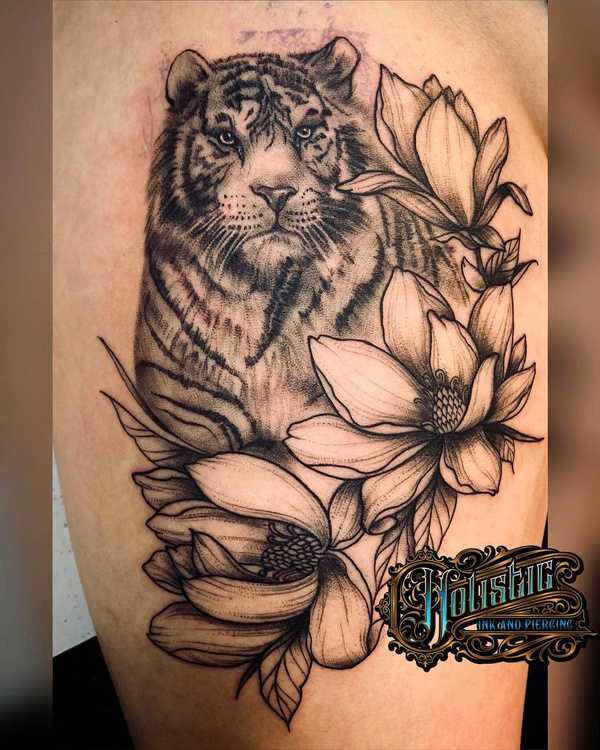
Rebirth and Transformation
Rebirth is a powerful theme in flower ink, symbolizing resilience and renewal. Flowers like the lotus, which grows from the mud to bloom beautifully, represent triumph over adversity and personal transformation. A flower tattoo representing rebirth can signify personal healing or the start of a new chapter after hardship. The journey from seed to bloom mirrors overcoming challenges, embracing change, and emerging stronger. These tattoos capture the endless potential for growth and transformation, no matter how many obstacles one faces. They serve as lasting reminders of the strength within to rise again, no matter the circumstances, and continue evolving into something more beautiful and whole.
Bloom tattoos that represent beginnings, endings, and renewal offer a powerful and meaningful way to commemorate the cycle of life. By incorporating flowers at different stages of their life cycle, these tattoos symbolize the interconnectedness of all experiences—growth, decline, and the constant opportunity for renewal.
The beauty of tattoos lies not only in their aesthetics but also in the deep meanings they carry. Flower tattoo designs symbolize the cycle of life, representing moments of birth, growth, transformation, and impermanence. From budding flowers that mark new beginnings to fully bloomed petals signifying personal evolution, each design tells a unique story. Even fading blossoms serve as a reminder of the impermanence of life, encouraging appreciation for every moment. Whether chosen to celebrate milestones, honor loved ones, or embrace change, these designs reflect the ever-evolving journey of existence, making them both meaningful and timeless.
Simple Flower Tattoos for Women: Elegant and Meaningful
Simple flower tattoos for women are a beautiful and timeless way to express personal style with elegance and grace. These tattoos often rely on minimalistic designs to create an impactful visual, allowing the beauty of the flower to shine through with just a few lines or subtle shading. Their understated nature makes them ideal for those who prefer a more delicate approach to body art, while still capturing the powerful symbolism flowers offer.
The Appeal of Minimalism in Floral Ink
The allure of simple flower body art for women lies in their ability to convey beauty without overwhelming the wearer. Minimalist designs often use clean lines, fine details, and negative space to allow the flower to stand out. This simplicity can be incredibly striking, emphasizing the natural elegance of the flower while maintaining an air of subtlety. It’s a perfect choice for those who want a tattoo that is meaningful yet doesn’t demand attention.
Many women choose bloom tattoos because they can be personal without being overly complex. A small lotus, for example, can symbolize spiritual growth and inner peace, while a daisy may represent innocence and purity. Even a single stem of lavender can carry deep meanings of calmness and tranquility. These tattoos allow women to express their values and emotions in a way that feels intimate yet timeless.
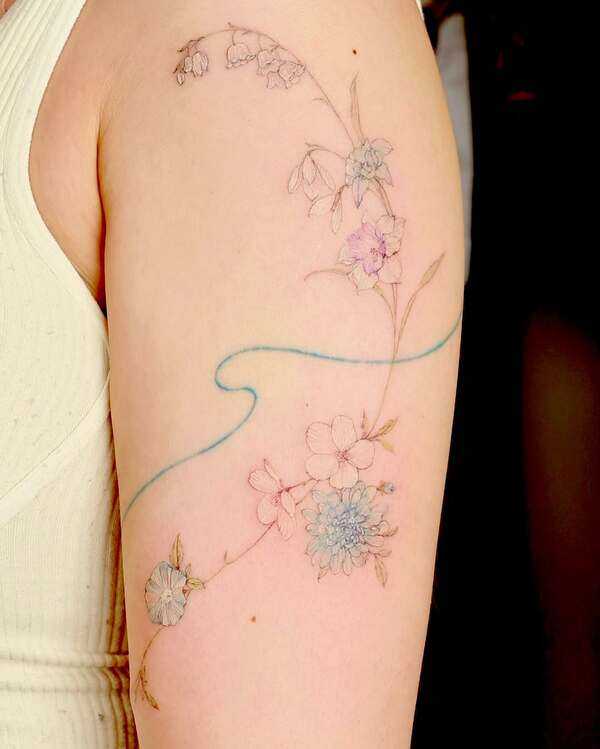
Placement and Design Considerations
Simple tattoos can be placed almost anywhere on the body, making them versatile and adaptable to individual preferences. Some popular spots include the wrist, ankle, collarbone, or behind the ear. These placements are subtle and allow the tattoo to be easily concealed or shown off depending on the occasion. Smaller tattoos are particularly suited for these areas, allowing them to blend naturally with the body’s lines.
In terms of design, tattoos often feature a single bloom or a small cluster, emphasizing the form and shape of the flower without excess detail. Fine lines and soft shading are commonly used to create a refined, understated look. These tattoos can be as bold or as delicate as desired, making them suitable for a variety of personal styles.
Timeless and Versatile
What makes simple flower tattoos so appealing is their versatility. They never go out of style, and their meanings remain relevant no matter the trends. Whether you’re a fan of vintage designs, contemporary art, or something more traditional, the simplicity of flower tattoos ensures that they can easily blend into any aesthetic. They’re the kind of tattoos that not only age beautifully but also continue to hold personal significance for years to come.
Combining Flower Ink Tattoos with Animals, Geometrics, and More
Flower ink has long been cherished for its intricate beauty and symbolic depth. However, by combining flowers with other elements like animals, geometric shapes, or abstract designs, these tattoos can evolve into truly unique pieces of art. The fusion of flowers with different motifs not only enhances the visual appeal but also adds additional layers of meaning, making the tattoo more personal and expressive. Here, we explore how to seamlessly incorporate various elements into floral tattoo patterns to create a cohesive, striking look.
Flowers and Animals: A Symbolic Union
One of the most popular combinations in tattoo art is the pairing of flowers with animals. This blend can create a powerful visual contrast and deepen the symbolism of both elements. For example, a lion surrounded by roses can represent strength, courage, and love, with the lion symbolizing bravery and the roses adding a touch of beauty and tenderness. Similarly, a butterfly resting on a delicate flower could symbolize transformation and growth, as butterflies are often associated with change, while the flower represents life and beauty.
Other animal-flower combinations include birds, wolves, and even mythical creatures like phoenixes. A wolf surrounded by wildflowers may represent freedom and the untamed nature of life, while an owl perched on a branch of cherry blossoms could symbolize wisdom, peace, and the cyclical nature of life.
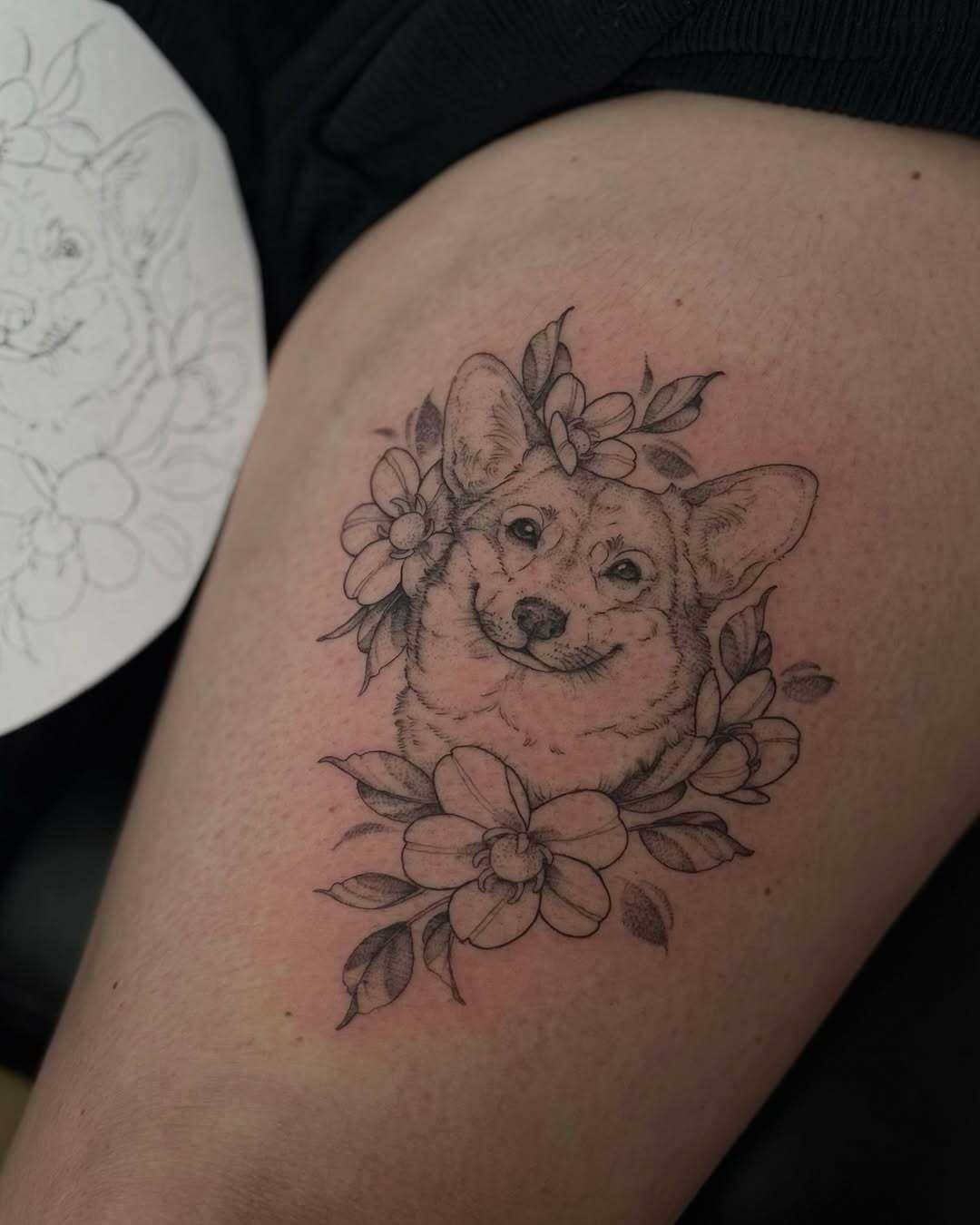
Incorporating Geometric Shapes
Geometric shapes add a contemporary twist to floral tattoos, blending organic and structured elements. Patterns like triangles, circles, or hexagons create symmetry and balance, enhancing the natural beauty of flowers.
A rose tattoo inside a geometric diamond contrasts sharp lines with soft petals, making for a striking design. Mandala patterns paired with flowers like lotuses create a spiritual, meditative tattoo symbolizing harmony and unity.
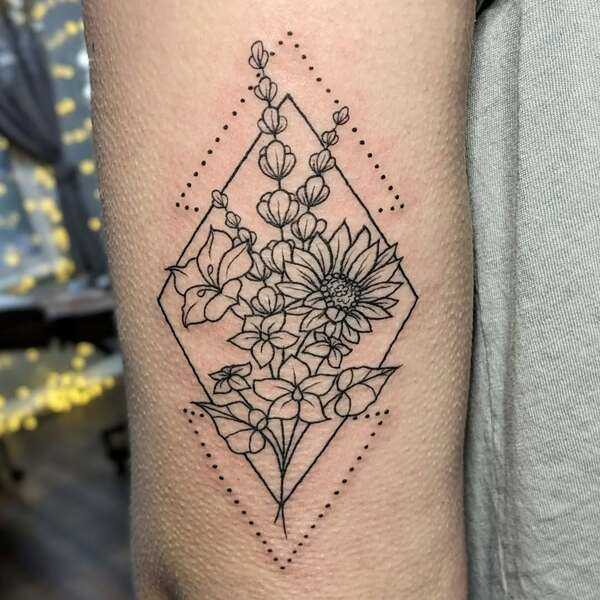
Abstract and Watercolor Designs
Watercolor tattoos, with their soft, blended colors, create a vibrant, flowing look when paired with floral designs. A flower tattoo with watercolor splashes can evoke movement and life, making it appear as if the bloom is unfolding on your skin.
Abstract art, emphasizing shapes and colors over realism, can frame or interact with floral tattoos. Surrounding a simple flower with abstract elements adds surrealism and emotional depth, allowing for creative expression through color gradients and shadow effects.
How Traditional Flower Tattoos Inspire Modern Body Art
Traditional flower tattoos have a rich history rooted in the early foundations of tattoo culture. Their enduring appeal lies in their bold lines, vibrant colors, and strong symbolism, making them a timeless source of inspiration for modern tattoo artists and enthusiasts alike. These tattoos, often featuring iconic flowers like roses, lilies, and peonies, have influenced contemporary designs by combining classic techniques with innovative interpretations.
Bold and Classic Design Elements
Classic floral tattoos are known for their bold, clean lines and flat, saturated color palettes, which are hallmarks of classic tattoo styles. These elements have made their way into modern tattoo trends, influencing artists who blend the old with the new. Contemporary artists often take the strong outlines and vivid colors of tattoos and integrate them with more intricate or subtle shading techniques. The result is a harmonious blend of past and present that gives the tattoo a sense of depth while retaining the bold impact of traditional designs.
This combination of old-school vibrancy and modern artistry allows flower tattoos to remain relevant and adaptable. For example, traditional roses with solid, striking colors may now be complemented by the soft gradients of watercolor effects, creating a beautiful juxtaposition between the classic and the contemporary.
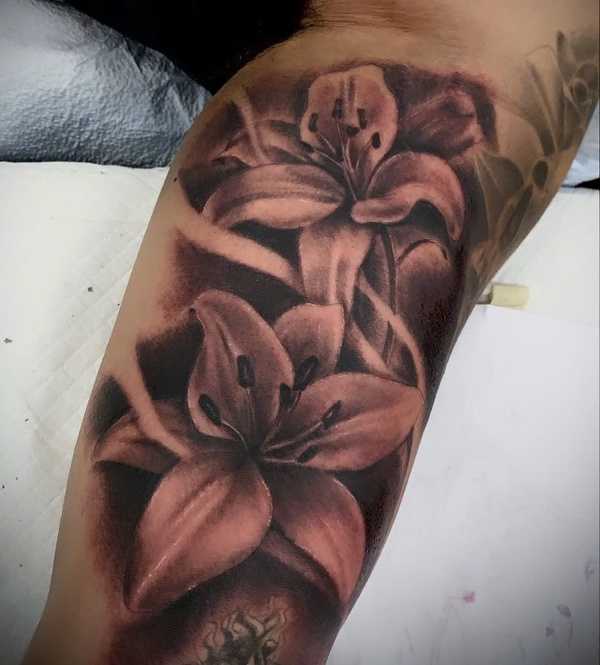
Fusion of Traditional and Contemporary Styles
Modern tattoo art merges classic floral motifs with innovative styles like realism, geometric patterns, and abstract designs. A tattoo may retain bold outlines and shading while incorporating geometric shapes or abstract elements for a unique twist.
Watercolor tattoos, with their soft, flowing hues, mirror the rich colors of classic botanical tattoos while offering a more ethereal look. This blend of techniques allows floral tattoos to continually evolve, appealing to both traditional and modern artistic expression.
Cultural Continuity and Artistic Legacy
Traditional floral ink holds deep cultural significance, especially in American and Japanese tattoo traditions. The American Traditional style, pioneered by Sailor Jerry, emphasized bold floral designs, while Japanese Irezumi featured symbolic flowers like chrysanthemums and cherry blossoms tied to seasonal and spiritual meanings. These historical influences still shape modern tattoo art, inspiring artists worldwide. By integrating classic motifs with contemporary innovations, today’s floral tattoos continue to honor artistic heritage while embracing new creative directions.
The evolution of tattoo artistry continues to blend heritage with innovation, creating designs that honor the past while embracing contemporary creativity. Traditional flower tattoos serve as a foundation for modern body art, influencing styles, techniques, and symbolism that remain timeless. By merging bold lines and classic motifs with new artistic approaches like watercolor, fine-line, and geometric elements, tattoo artists bring fresh interpretations to floral ink.
In conclusion, flower tattoos are not only a beautiful form of body art but also a profound representation of life’s most fundamental aspects—growth, change, and the passage of time. By choosing flowers that resonate personally, individuals can capture the essence of birth, death, and rebirth, symbolizing both the fragility and strength inherent in life’s journey. Whether representing new beginnings, honoring lost loved ones, or celebrating personal transformation, flower tattoos continue to serve as timeless symbols of nature’s cycles, reminding us of the beauty and impermanence that shape our existence.

